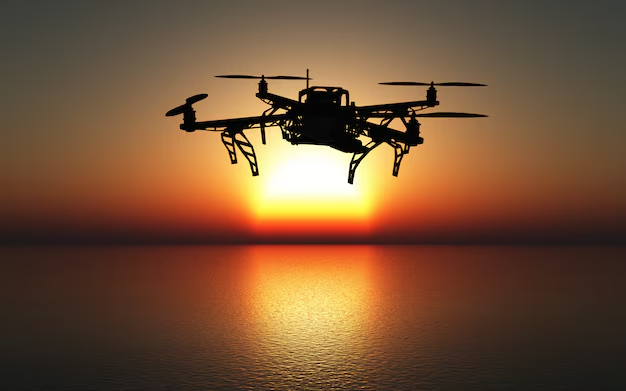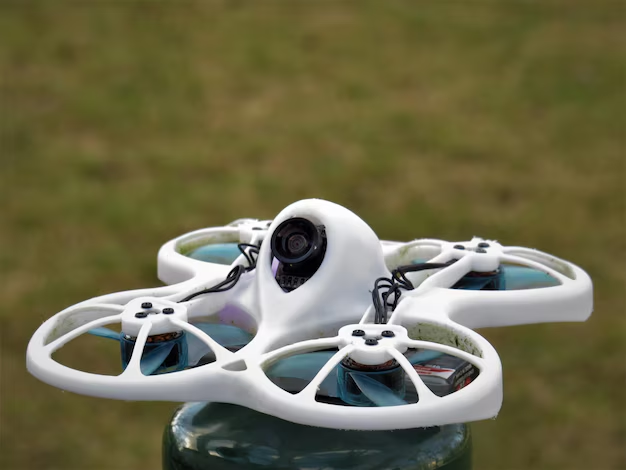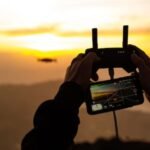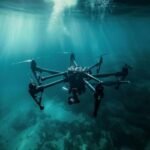Drone camera sensors play a crucial role in capturing high-quality aerial images and videos by detecting light, color, and environmental details with precision. These sensors vary in size, type, and technology, influencing image resolution, dynamic range, and low-light performance. Common types include CMOS and CCD sensors, with CMOS being widely used for its efficiency and fast processing speed. Advanced drones also feature thermal, infrared, and multispectral sensors for specialized applications like mapping, surveillance, and agriculture. Understanding drone camera sensors helps in choosing the right drone for professional or recreational use, ensuring optimal performance for various shooting conditions.
1. Sony Exmor R CMOS Drone Camera Sensor (DJI Mavic 2 Pro)
- Camera Resolution: 20 MP
- Video Resolution: 4K at 30 fps
- Sensor Type: CMOS
- Dynamic Range: 12.8 stops
- Price: $1,599
- Where to Buy: DJI, Amazon, Best Buy
Pros:
- Exceptional image quality with high dynamic range
- Larger 1-inch sensor captures more light
- Great for professional cinematography
- Excellent low-light performance
- Compatible with various lenses
Cons:
- Expensive
- Heavy and bulky compared to other drones
- Limited portability
- High learning curve for beginners
- No obstacle avoidance in all directions
How to Use: Use the DJI Go 4 app for precise control over camera settings and flight modes.

2. Micro Four Thirds Drone Camera Sensor (DJI Mavic 3)
- Camera Resolution: 20 MP
- Video Resolution: 5.1K at 50 fps
- Sensor Type: CMOS (Micro Four Thirds)
- Dynamic Range: 12.8 stops
- Price: $2,049
- Where to Buy: DJI Store, Amazon, Best Buy
Pros:
- Excellent video and photo quality with higher resolution
- Long battery life (up to 46 minutes)
- Large sensor for better image clarity and depth
- Improved low-light performance
- Advanced obstacle sensing with omnidirectional sensors
Cons:
- Expensive for casual users
- Larger and heavier than some competitors
- Complex settings for new users
- Not ideal for extreme portability
- More suited for professional use
How to Use: Pair with the DJI Fly app to access advanced video and camera controls. Use the advanced intelligent flight modes for smoother footage.
3. 1-Inch CMOS Drone Camera Sensor (Autel Robotics EVO II Pro)
- Camera Resolution: 50 MP
- Video Resolution: 6K at 60 fps
- Sensor Type: CMOS
- Dynamic Range: 12.8 stops
- Price: $1,795
- Where to Buy: Autel Robotics, Amazon, Best Buy
Pros:
- Top-tier image and video quality
- 6K video for professional content creation
- Longer flight time (up to 40 minutes)
- Enhanced sensor for detailed images
- Compact and portable design
Cons:
- Expensive for casual users
- Large file sizes
- Learning curve with advanced settings
- Limited software options for beginners
- Some flight mode limitations
How to Use: Use the Autel Explorer app for intuitive flight control and camera adjustments.
4. CMOS Drone Camera Sensor (Skydio 2)
- Camera Resolution: 12 MP
- Video Resolution: 4K HDR at 60 fps
- Sensor Type: CMOS
- Dynamic Range: 14 stops
- Price: $999
- Where to Buy: Skydio, Amazon, Best Buy
Pros:
- Best-in-class autonomous flight capabilities
- Excellent video quality with HDR
- Outstanding obstacle avoidance
- Easy to use for beginners
- Great for hands-free filming
Cons:
- Shorter battery life (23 minutes)
- Limited max flight range (3.5 km)
- Expensive for casual users
- Limited camera resolution compared to others
- Requires good lighting for best results
How to Use: Use the Skydio app for hands-off flying or connect the optional Skydio controller for manual operation.

5. CMOS Drone Camera Sensor (DJI Air 2S)
- Camera Resolution: 20 MP
- Video Resolution: 5.4K at 30 fps
- Sensor Type: CMOS
- Dynamic Range: 12.8 stops
- Price: $999
- Where to Buy: DJI, Amazon, Best Buy
Pros:
- Incredible 5.4K video quality
- Excellent camera performance in low light
- Lightweight and portable
- Advanced safety features (obstacle sensors)
- Great battery life (31 minutes)
Cons:
- Expensive for casual users
- No 360° obstacle avoidance
- Can be challenging for beginners
- Limited max range compared to other premium drones
- No advanced 4K 60 fps option
How to Use: Control the drone through the DJI Fly app, where you can easily set camera modes and flight modes for smoother operation.
6. 1/2.3-Inch CMOS Drone Camera Sensor (Parrot Anafi)
- Camera Resolution: 21 MP
- Video Resolution: 4K HDR
- Sensor Type: CMOS
- Dynamic Range: 10 stops
- Price: $699
- Where to Buy: Parrot, Amazon, Best Buy
Pros:
- 180° tilt camera
- Affordable for a 4K drone
- Great for VR compatibility
- Compact and lightweight
- Good for casual video recording
Cons:
- No obstacle avoidance
- Limited flight range (4 km)
- Shorter battery life (25 minutes)
- No advanced camera settings
- Stability can be compromised in wind
How to Use: Control the drone with the FreeFlight app, which allows easy camera control and flight adjustments.
7. Full HD Drone Camera Sensor (Holy Stone HS720E)
- Camera Resolution: 4K EIS (Electronic Image Stabilization)
- Video Resolution: 4K at 30 fps
- Sensor Type: CMOS
- Dynamic Range: Moderate
- Price: $299
- Where to Buy: Holy Stone, Amazon, Best Buy
Pros:
- Affordable 4K camera
- GPS-assisted stability
- Return-to-home feature
- Great for beginners
- Easy-to-use controller
Cons:
- No obstacle avoidance
- Limited range (1 km)
- No advanced video features
- Shorter battery life
- Basic camera stabilization
How to Use: Use the included remote controller and app for easy flight and camera control.
8. 12 MP CMOS Drone Camera Sensor (FIMI X8 SE)
- Camera Resolution: 12 MP
- Video Resolution: 4K at 30 fps
- Sensor Type: CMOS
- Dynamic Range: 10 stops
- Price: $399
- Where to Buy: FIMI, Amazon, Best Buy
Pros:
- Excellent range (8 km)
- Compact and portable
- Affordable with good camera specs
- Stable GPS control
- High-quality 4K video
Cons:
- Basic camera gimbal
- No follow-me mode
- No obstacle avoidance
- Limited app functionality
- No 60 fps video at 4K
How to Use: Pair the FIMI X8 SE with your smartphone and use the FIMI app to control flight and camera settings.
9. GoPro Karma Drone – 12 MP Camera with Hero5 Integration Drone Camera Sensor
- Camera Resolution: 12 MP (GoPro Hero5 Integration)
- Video Resolution: 4K at 30 fps
- Sensor Type: CMOS (GoPro Hero5 sensor)
- Dynamic Range: Moderate
- Battery Life: 20 minutes
- Price: $799
- Where to Buy: GoPro, Amazon, Best Buy
Pros:
- Versatile camera system with GoPro Hero5 integration
- 4K video resolution for high-quality footage
- Easy to control, suitable for beginners
- Lightweight and portable design
- Good stabilization for video recording
Cons:
- Limited flight time (20 minutes)
- No obstacle avoidance
- Can be noisy during flight
- No advanced flight modes
- GoPro Hero5 camera quality is not on par with newer models
How to Use: The Karma drone integrates seamlessly with GoPro’s Hero5 camera. The controller has an intuitive touch screen for managing flight and camera settings. You can use the GoPro app for camera controls and sharing content.
10. Hubsan Zino 2 Pro – 1/2.3-Inch CMOS Drone Camera Sensor
- Camera Resolution: 48 MP
- Video Resolution: 4K at 60 fps
- Sensor Type: 1/2.3-Inch CMOS
- Dynamic Range: High
- Battery Life: 33 minutes
- Price: $599
- Where to Buy: Hubsan, Amazon, Best Buy
Pros:
- High-resolution 48 MP camera for sharp, detailed photos
- 4K video at 60 fps for smooth and cinematic footage
- Affordable for its feature set
- Stable GPS flight system
- Long flight range (up to 8 km)
Cons:
- Limited obstacle avoidance
- No obstacle sensors for 360-degree protection
- Shorter battery life compared to higher-end drones
- The camera quality may degrade slightly in low light
- The app can be less reliable at times
How to Use: The Hubsan Zino 2 Pro can be controlled via the Hubsan app, which allows you to configure camera settings, flight paths, and monitor real-time video feed. It’s suitable for both beginners and experienced drone pilots seeking an affordable 4K option.
Conclusion:
In conclusion, drone camera sensors are essential for capturing high-quality imagery, with their type and technology significantly impacting performance. Whether using CMOS for speed and efficiency or specialized sensors like thermal and multispectral for advanced applications, the right choice depends on the intended use. As drone technology evolves, sensors continue to improve, offering better resolution, dynamic range, and adaptability to different lighting conditions. By understanding these sensors, users can make informed decisions, ensuring optimal results for photography, videography, mapping, and other professional applications.



